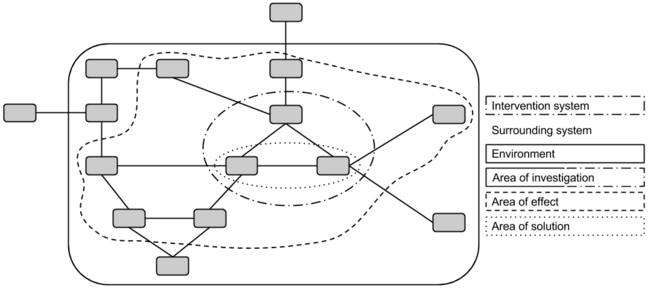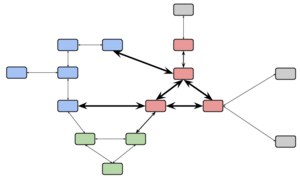Analysis of the current state
Pppm student (Talk | contribs) (→Analysis of the current state) |
Pppm student (Talk | contribs) (→Analysis of the current state) |
||
| Line 42: | Line 42: | ||
The different connections between the elements can differ from flows of resources such as in-formation, energy or physical parts moving between elements etc., meanwhile the elements can differ between stakeholder, organizations, departments, persons, processes or machines etc. | The different connections between the elements can differ from flows of resources such as in-formation, energy or physical parts moving between elements etc., meanwhile the elements can differ between stakeholder, organizations, departments, persons, processes or machines etc. | ||
The type of connection and element is depending on the type of project it is used in and where the overview is needed. | The type of connection and element is depending on the type of project it is used in and where the overview is needed. | ||
| − | One system can contain more than one point of view that are interesting. Therefore, the same system can be illustrated with different flows to get the necessary overview of the situation as shown on the figure below <ref name=''Book'' | + | One system can contain more than one point of view that are interesting. Therefore, the same system can be illustrated with different flows to get the necessary overview of the situation as shown on the figure below <ref name=''Book''>. |
[[file:Situation_analysis_fig2.png|border|Example of different flows in same system|none|400px]] | [[file:Situation_analysis_fig2.png|border|Example of different flows in same system|none|400px]] | ||
Revision as of 00:16, 25 November 2014
Contents |
Abstract
This article considering the analysis of the current state that are a part of the situation analysis. The different possibilities getting an overview of the current state are highlighted through the article. Using system demarcation, it is possible to get an overview of complex structures, bene-ficial for project and program management and people in project groups. The tool are used to make an overview of communications, stakeholders and flows of different resources and are very simple to use. The good project result is always based on the well-defined task and well-known overview of the situation.
Introduction
This article will describe and discuss tools in the situation analysis that is the first step in the problem solving cycle (PSC). The method comprises a systematic analysis of the situation and are used to formulate goals and create the necessary overview to search for solutions within the given project.
The problem solving cycle are constructed with overlapping steps that continues until the project demands, conditions are met or the project resources are depleted. It is based on information flow and are starting with a focus on the problem recognition and problem definition. [1]
The situation analysis can furthermore be divided into more steps, such as task analysis, analysis of the current state, analysis of the future and at last, an identification of the problems and actions that needs to be taken. The primary focus in this article will be on the analysis of the current state and view methods that can give an overview of the environment and connections within complex systems. The basic rule is to get an overview and thereafter it is possible to demarcate the system from its environment.
At the start of a project it is very important to know exactly; what is the task or tasks in the given project? To solve a problem it should be clear for both the project group but especially for the project manager what the task is. Therefore, the task should be stated correctly in the start of the project. This task analysis can be made by analyse and question the task with critique questions. Furthermore, important aspects should be identified in the system. A detailed study will be good for the analysis of the current state.
Analysis of the current state
The system demarcation is an essential tool to get an overview of complex situations in the cur-rent state. To manage projects it is often important to know the system and its surrounding environment where the project are going on. Here a system demarcation can be used to get an overview of the situation. It can be marked into following six overlapping areas to identify the most important parts of the system:
- Intervention System
- Surrounding System
- Environment
- Area of investigation
- Area of effect
- Area of Solution
The different areas need to be found to demarcate the system to make the work easier for the project team. It is often important to use the resources right and ensure the project group are working on the real problem in the right direction. If the situation are unknown, it is hard to find the best solution for the tasks within the project. A example of a demarcation of a system with the different areas are shown on the following figure.
The five important terms are described below [2] [3]:
Intervention system is the area where interventions and modifications that are related to the problem can be made.
Surrounding system is all the area that are external to the intervention system.
Environment is that part of the surrounding system that are relevant to the problem it selves.
Area of investigation is the sum of the intervention system and the environment.
Area of effect is the area that where effects from the solution can be expected. This can include parts of the surrounding system.
Area of solution is the part of the intervention system that is used for the solution.
The different connections between the elements can differ from flows of resources such as in-formation, energy or physical parts moving between elements etc., meanwhile the elements can differ between stakeholder, organizations, departments, persons, processes or machines etc. The type of connection and element is depending on the type of project it is used in and where the overview is needed. One system can contain more than one point of view that are interesting. Therefore, the same system can be illustrated with different flows to get the necessary overview of the situation as shown on the figure below Cite error: Closing </ref> missing for <ref> tag
An often used tool during stakeholder analysis is a power/interest grid or power/influence grid that group the stakeholders based on their level of authority. By using the system demarcation tool as a “stakeholder map” showing the stakeholders connections, it can help defining their authority within the project. The amount of authority are often related to their connections and coordinates between each other.
Recognizing strengths and weaknesses in the areas require knowledge about flows and condi-tions that the system demarcation can help creating. There are many options using the graphical tool. The different options besides the black boxes and system hierarchy could include more variables. An option could be to use varying line types, arrow sizes, colors etc.
References
- ↑ M.J. Kolkman & M. Kok & A. van der Veen (2005), Mental model mapping as a new tool to analyse the use of information in decision-making in integrated water management, Physics and Chemistry of the Earth 30 (p. 317-332)
- ↑ C. Thuesen & J. Oehmen, DTU Course 42433 Advanced Engineering Project, Program and Portfolio Management Lecture 3 slides
- ↑ R. Züst & P. Troxler, No More Muddling Through Mastering Complex Projects in Engineering and Management, Springer (2006)

